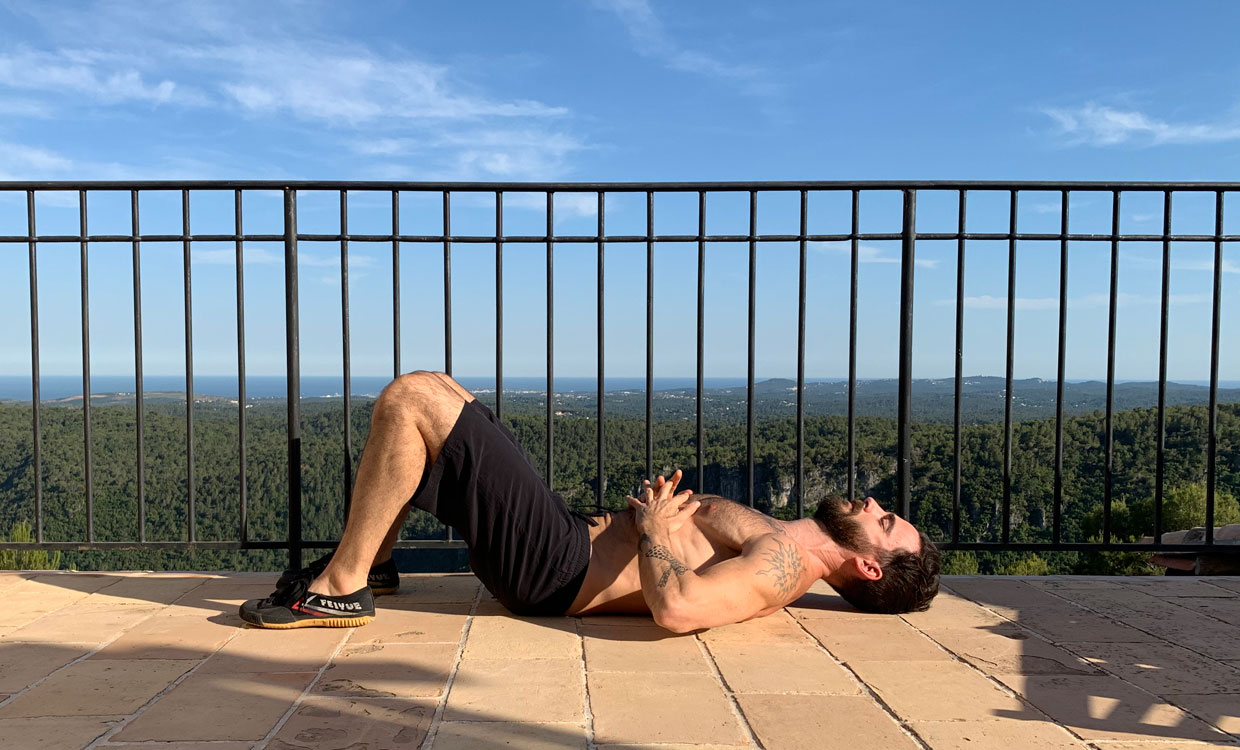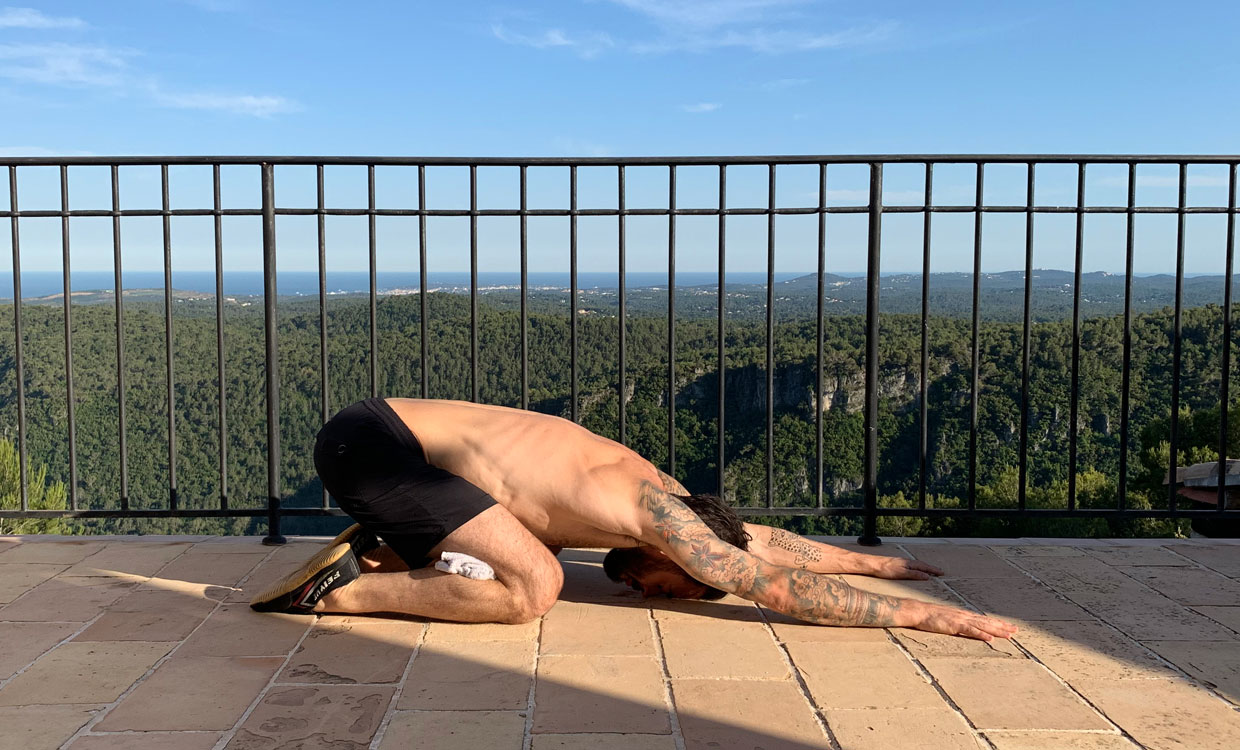8 Essential Post-Race Recovery Yoga Exercises Every Endurance Athlete Should Do

In honor of the United Nation's 5th annual International Day of Yoga, celebrated by people worldwide on June 21, we tapped Benjamin Sears, internationally-renowned yoga teacher and certified Functional Range Conditioning (FRC) movement specialist, on how to use yoga for recovery training. Here, he shares his go-to Spartan-worthy moves for winding down after a race. Do these after crossing the finish line, and you'll be well on your way to recovery.
We get it. When you're gassed after miles of running, obstacles, and burpees on burpees, more movement is the last thing you want to do. After all, you just busted your butt (and mind) to get across the finish line. But before you reach for a cold beer to celebrate your triumph, know this: If you don't take time to recover properly, you may be putting yourself at risk of injury.
"People often think of injury as 'I fell down, therefore I got hurt,'" says Benjamin Sears, yoga teacher and FRC specialist. "But one of the most common reasons injuries occur is repetitive action that creates patterns of stress in the body." Over time, this stress leads to the acute incidents that leave you seriously hurting.
Taking the time to restore—especially after a race, when you've pushed yourself to the max—will not only help you feel better the next day but also "program a healthier pathway for your body going forward," says Sears. That's why Sears recommends yoga for recovery training.
Why Yoga For Recovery Training?
Here, Sears shares a series of yoga-inspired moves specifically designed for athletes who've just finished a Spartan Race. These moves create space in the lower back, helping to counter any strain it feels from accommodating the body's strength and mobility imbalances throughout the race.
An added bonus: "These recovery moves help twofold, because the kidneys and adrenals are located in the lower back," says Sears. When your back is tight, it can trigger an adrenal response (think 'fight or flight' mode) that makes it harder to relax. Creating space not only wards off physical pain, but helps you calm down, too.
In all, this ultra low-maintenance recovery sequence takes just 10 minutes. Designed with minimal movement and maximum recovery, it'll help you rehab and get back on the trail in no time.
You'll need: A towel or t-shirt, a cell phone timer
1. Ab-Activated Lumbar Traction

Prepare a 1-minute timer
Lie flat on your back. Bend your knees and place your feet flat on the ground. Put your hands on your lower abs. Inhale, breathe down into your hips and lower stomach using the air pressure to press your lower back flat into the ground. Exhale, pull in the lowest part of your abdomen, all the way down by your pubic bone. Continue to press your lower back into the ground. Feel for a lengthening sensation in your lower back. Take three rounds of breath like this, then move your hands to your lower ribs. Inhale and use your hands to press your ribs together, sending your breath down into your abs, not up into your chest. Exhale, and pull your low abs in even more. On your next inhale, reach the top of your head away from your shoulders, keeping your ribs closed. Then, exhale and press your low back down.
Set a timer for one minute and continue this breathing method. Try to press any irritated areas of your lower back into the ground without hunching your upper back or shoulders.
Yoga for recovery training benefits: This move is a great way to understand how your abs can operate to support your lower back. And being breath-focused, it supports one of your most important recovery systems: getting oxygen to your muscles.
2. Wrist CARs (Controlled Articular Rotations)

Sit in a kneeling position (or stand if kneeling is uncomfortable). Grip your right lower forearm, just above the wrist, with your left hand. (This stabilizes the bones on the inside and outside of your arm.) Press your right fingers and thumb together, and slowly make the biggest circle you can through your wrist's entire range of motion. Don't let your forearm turn or your fingers bend or come apart. Do five circles, slowly, in each direction. Throughout the movement, feel for both an activation of the muscles that on the flexed side of your wrist and a stretch on the opposite side. Repeat on the other wrist.
Yoga for recovery training benefits: This move decompresses your wrist without applying external pressure to relieve stress from hanging on upper-body obstacles.
3. Wrist, Biceps & Chest Active Stretch

Prepare a 2-minute timer
From a tabletop position on all fours, flip your hands so your palms down and your fingers face backwards. Rotate your wrists all the way so that your inner wrist faces straight away from you. (If you have pain or very tight wrists, walk your knees closer to your hands.) Press down with your shins and feet to tuck your tailbone so that your lower back is long.
Related: Yoga for Injury Prevention During Your Training
Start your timer. For 10 seconds, press every part of your palm, base of your hand, and fingertips down. Straighten your arms, turn your biceps outwards, and feel for a stretch in your forearms. After ten seconds of pushing, inhale into your abdomen, exhale halfway, then try to lift your fingertips off of the ground without moving anything else. This will feel intense, and it’s okay if your fingertips don’t come up. Keep your head in line with the rest of your spine and maintain the push with the base of your hands. Repeat the 10-second push and 10-second fingertip lift for two minutes.
Yoga for recovery training benefits: This move strengthens under-developed muscles that extend your wrist. It also stretches out your hands, fingers, forearms, biceps, and chest, which will decrease tightness and facilitate fuller breathing.
4. Scapular CARs

Kneel or stand, engaging your core and ribs (like in the ab-activated lumbar traction exercise). Place your arms by your sides, make fists, and contract your triceps. Without moving anything else, squeeze your shoulders up to your ears, then pull them back, down, rotate them forward, and repeat. Aim to touch the furthest points you can throughout the rotation. Go slowly, and repeat five times in each direction. Pause in any sticky spots, and use your exhales to find a little more range. Keep your head and ribcage still.
Yoga for recovery training benefits: When you're crushing Spartan obstacles that require immense shoulder mobility, it’s almost impossible to maintain good shoulder positioning, which can cause neck irritation. This move is a shoulder reset and active neck release.
5. Hip CARs
From a tabletop position, firm your core and tuck your tailbone, so that there is no bend in your lower spine. Push the floor away. (Don't squeeze your shoulder blades together). Don't allow your back to arch, or your hips to lift or sway to one side. (This is crucial as you make a complete circle with your upper leg bone inside the hip socket.)
Bring your knee towards your chest. When you get as far as you can, open your knee out to the side, rotating your hip externally. When you can't move your knee any further out to the side without compromising your neutral spine, start to reach your foot towards the ceiling (this is internal rotation) and draw a circle with your knee back behind you. Keep your leg bent and reach your heel upwards. Keep your lower abdominals strong, and feel for a stretch in the front of your hip and activation in the back of your leg and glutes. Then, bring your knee forward towards your chest again. Do two more circles like this, and then three in the other direction. Repeat with your other leg.
Yoga for recovery training benefits: As a Spartan athlete, you know that much of your power comes from your hips. This move, in Sears' opinion, is the single most crucial exercise for hip health and mobility. These rotations prioritize moving bones properly, which helps muscles fire correctly so that you maintain a functional range of motion. They're great for unwinding tension in the hips and low back–as long as you truly isolate the hip by keeping your tailbone down and core engaged.
6. Spine-Lengthening Shoulder Stretch

Position yourself with your knees down, arms straight out in front of you, and your thumbs up. Reach forward, tuck your tailbone, and stretch your armpits towards the floor without arching your back. (You should have a tiny arch in your middle back and continuously lengthen your tailbone down.) Feel for a stretch in your shoulders and down your back. With each exhale, pull your lower abs and ribs in to lengthen your back.
Yoga for recovery training benefits: This move builds core strength and stretches all areas that inhibit shoulder flexion. It also lengthens out your lower back.
7. Spinal Twist

Kneel down with your feet together and knees shoulder-width apart. Roll up a towel or t-shirt and place it behind your knees to create a little space in the joint (which helps if your knees are tight). To twist to the right, place your right palm down just outside and to the right of your right shoulder. Threat your left arm behind your right, and plant your left fist outside of your right hand, with your palm up. Keep your hips still. You'll want to isolate your spine as you twist.
Inhale and reach your left fist away from you while pressing your shoulder and rear deltoid towards the ground. Exhale and push down with your right hand to help you twist. Keep your head in-line with your spine. Engage your abs and lower ribs, and notice a little backbend between your shoulder blades. As you twist to the right, reach your left hip back; imagine both hips touching the wall behind you the whole time. Take ten deep breaths. Repeat on the left side.
Yoga for recovery training benefits: This move combines hip flexion with a spinal twist to re-align our spine after you've moved in multi-directions and planes during your race.
8. Passive Stretch & Cool Down

Prepare a 2-minute timer
Keep the same lower body positioning as the Spinal twist, and simply extend both arms out in front of you. Keep your palms flat and rest your forehead on the ground. Spend two minutes in this position. Breathe in for four counts and out for eight counts. This simple breath pattern in this posture will down-regulate your nervous system and help you wind down.
Pro tip: On the inhale, feel for tilting your pelvis slightly back and up. On the exhale, engage your low abs to pull tailbone slightly forwards.
Yoga for recovery training benefits: This move is the ultimate passive stretch–and a great finisher any time you employ yoga for recovery training. Combined with the breath pattern, it lengthens your back, stretches your shoulders, and helps your nervous system chill out after an intense race.
Benjamin Sears leads yoga workshops and teacher trainings around the world, and hosts award-winning luxury wellness retreats at LUXYOGA in the South of France. Follow him on Instagram (@Benjamin.Sears) for functional conditioning tips, inspiration, workouts, and more.

